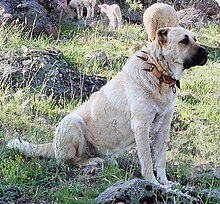Wolf collar
- Machine translation, like DeepL or Google Translate, is a useful starting point for translations, but translators must revise errors as necessary and confirm that the translation is accurate, rather than simply copy-pasting machine-translated text into the English Wikipedia.
- Do not translate text that appears unreliable or low-quality. If possible, verify the text with references provided in the foreign-language article.
- You must provide copyright attribution in the edit summary accompanying your translation by providing an interlanguage link to the source of your translation. A model attribution edit summary is
Content in this edit is translated from the existing Catalan Wikipedia article at [[:ca:Collar de punxes]]; see its history for attribution. - You may also add the template
{{Translated|ca|Collar de punxes}}to the talk page. - For more guidance, see Wikipedia:Translation.



A wolf collar (also known as Italian: roccale or vreccale, Spanish: carlanca) is a type of dog collar designed to protect livestock guardian dogs from attack by wolves. Wolf collars are fitted with elongated spikes to stop wolves from attacking dogs on the neck. Such collars are used by shepherds in many countries including Italy,[citation needed] Spain[1] and Turkey.
Ancient Greeks used such collars to protect their dogs from wolf attacks.[2]
In Latin the collar was called mellum or maelium or mellum or millus.[3][4] Marcus Terentius Varro wrote that the farm dogs should have spiked collars for protection against wolves and other wild animals.[5]
War dogs in ancient Greece and Rome had collars with large spikes.[6][7]
Use
A wolf collar is normally made out of metals such as steel. The length of the spikes can be quite long, but styles differ in different places.[citation needed] The dogs that normally wore the collars were ones used to protect livestock from attack by wolves. The purpose of the collar is to protect the dog wearing it when it has to fight the wolves. The collar base protects the dog's throat and carotid arteries, while the spikes are intended to deter bites to the neck or even injure wolves trying to do so. There are some tales that suggest that dogs were only given them after they had killed their first wolf; however, these are normally considered to be inaccurate.[citation needed]
References
- ^ Charles Bergman, Jorge Sierra (1997). Spain's Wolf Wars. International Wildlife. 27 (2): 22–29. (subscription required).
- ^ Dogs in the Ancient World "The dog was companion, protector, and hunter for the Greeks and the spiked collar, so well known today, was invented by the Greeks to protect the necks of their canine friends from wolves."
- ^ Harry Thurston Peck, Harpers Dictionary of Classical Antiquities (1898), Millus
- ^ Charlton T. Lewis, Charles Short, A Latin Dictionary, mellum
- ^ A Dictionary of Greek and Roman Antiquities (1890), Collare
- ^ Blackwood's Edinburgh Magazine, Volume 144, 1888, p. 699
- ^ United States War Department (1943). War Dogs. U.S. Government Printing Office. p. 5.
Sources
- Brenda M. Negri, Spiked Collars Give LGDs an Edge, Farm Show Magazine Brenda M. Negri, Spiked Collars Give LGDs an Edge
- Goat Rancher Magazine article on Spiked Protective Collars by Brenda M. Negri










